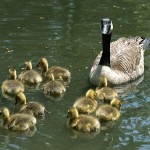Don’t Call Them Canadian Geese
by Paul Stein
The ubiquitous Canada goose is one of the most recognized birds in North America. In Calaveras County, these large tan and black birds with the banded neck can be seen along waterways or migrating in familiar V-shaped patterns which herald the beginning of spring. Canada geese (not “Canadian”) were once endangered from over-hunting, but are now plentiful throughout the contiguous U.S. and Canada.
 Canada geese are very adaptable and thrive wherever grasses, grains, or berries are available. They prefer nesting near bodies of water where their newly hatched goslings can evade predators. Because of changing weather, settlement, and farming patterns, many Canada geese have altered their annual migrations. Typically, the birds summer in northern North America and fly south when cold weather arrives. This cycle endures, but some northern populations have shortened their flight to traditional wintering grounds in the southern U.S. and Mexico. Many Canada geese have become permanent residents of parks, golf courses, and other human habitats across much of the U.S. In some areas, such as airports, they are so numerous that they are considered a nuisance. They are prolific grazers. Just 50 geese can produce two and a half tons of excrement in a year.
Canada geese are very adaptable and thrive wherever grasses, grains, or berries are available. They prefer nesting near bodies of water where their newly hatched goslings can evade predators. Because of changing weather, settlement, and farming patterns, many Canada geese have altered their annual migrations. Typically, the birds summer in northern North America and fly south when cold weather arrives. This cycle endures, but some northern populations have shortened their flight to traditional wintering grounds in the southern U.S. and Mexico. Many Canada geese have become permanent residents of parks, golf courses, and other human habitats across much of the U.S. In some areas, such as airports, they are so numerous that they are considered a nuisance. They are prolific grazers. Just 50 geese can produce two and a half tons of excrement in a year.
When the geese migrate in the spring and fall, they form impressive and aerodynamic V-shaped formations known as a skein. This flight pattern reduces drag and increases efficiency in flight. The point position is rotated since flying in front consumes the most energy. Canada geese can travel in excess of 1,500 miles a day with a favorable wind, but typically travel at a much more leisurely rate. These noisy groups honk their way along established paths that include designated “rest stops.” The honking is thought to be a form of communication to assist the flock in maintaining a tight formation. These social birds remain in flocks year-round, except while nesting.
 During the second year of their lives, Canada Geese chose a mate. They are monogamous, and most couples remain together all their lives. If one dies, the other may find a new mate, but this is not typical. The female normally lays 3-8 tan colored eggs and both parents protect the nest while the eggs incubate; but the female spends more time at the nest than the male. The incubation period lasts for approximately 24-28 days after all the eggs are laid. When the goslings hatch is also when the annual summer molt takes place. The adults will regain their flight feathers at about the same time the young geese start to fly.
During the second year of their lives, Canada Geese chose a mate. They are monogamous, and most couples remain together all their lives. If one dies, the other may find a new mate, but this is not typical. The female normally lays 3-8 tan colored eggs and both parents protect the nest while the eggs incubate; but the female spends more time at the nest than the male. The incubation period lasts for approximately 24-28 days after all the eggs are laid. When the goslings hatch is also when the annual summer molt takes place. The adults will regain their flight feathers at about the same time the young geese start to fly.
Adult geese are often seen leading their goslings in a line, usually with one parent at the front, and the other at the back. While protecting their goslings, parents often violently chase away nearby creatures, after giving off a preemptory hissing warning. The warning escalates to a full on attack with bites and slaps of the wings if the threat does not retreat or has seized a gosling. Although parents are hostile to unfamiliar geese, a few adults will often form groups of goslings, called crèches, to help protect their young progeny.
The offspring enter the fledging stage any time from 6 to 9 weeks of age. They do not leave their parents until after the following spring migration, when they return to their birthplace. Once they reach adulthood, Canada Geese are rarely preyed on by anything beyond humans, but can be taken by Coyotes, Gray Wolves, Snowy Owls, Golden Eagles and Bald Eagles.
Canada goose populations represent a successful wildlife protection program that revived dwindling numbers in the beginning of the 20th century. Before restoration efforts by Fish and Wildlife authorities these birds were hunted to near extinction. Conservation efforts and tightly controlled bag limits has seen a resurgence of this popular bird. Currently, management concerns center on keeping populations in check because of their detrimental effect on crops and the nuisance they can become near water features along housing developments.
The next time you see the majesty of a migrating flock of Canada Geese in their familiar V-shaped pattern, remember how determined and devoted these birds are to the family unit. And be of good cheer, heartened that the cycle of life continues for another year.
Paul Stein is a biologist with a long career in aquaculture. He was formerly Chief Deputy Director of the California Department of Fish & Wildlife. He can be reached at [email protected]




